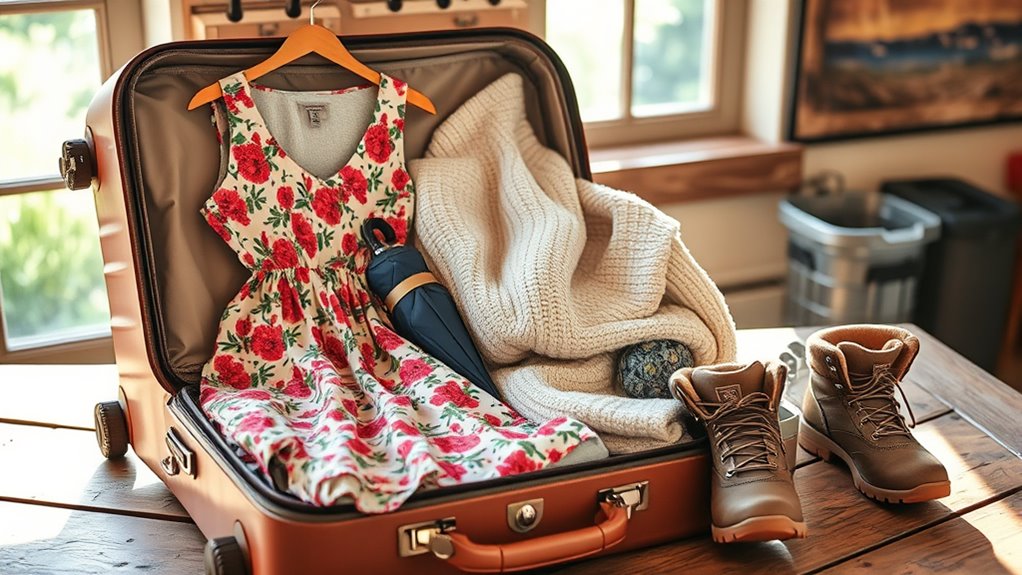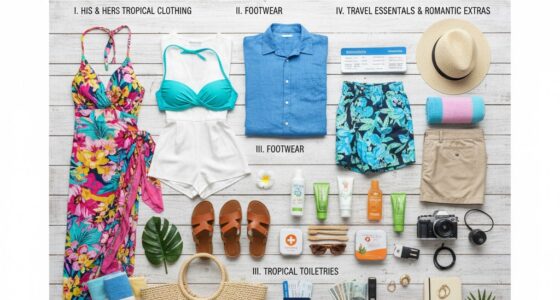To pack for multiple climates, analyze your destination’s weather patterns and prepare versatile, layered clothing that can adapt to sudden changes. Choose waterproof shoes and gear, and organize your luggage with packing cubes for quick access. Bring lightweight, quick-drying fabrics, and include essentials like rain jackets, thermal layers, and sun protection. Staying flexible and organized helps you stay comfortable regardless of unpredictable weather—keep going to discover how to master this planning process effectively.
Key Takeaways
- Analyze historical climate data and monitor weather forecasts to anticipate temperature fluctuations and seasonal variations.
- Pack versatile, layered clothing made from quick-drying, moisture-wicking fabrics suitable for varying weather conditions.
- Include multi-purpose gear like waterproof jackets, foldable umbrellas, and adaptable footwear for different climates.
- Organize belongings with packing cubes and compartments to easily access weather-specific items and reduce packing stress.
- Prepare for weather changes by carrying essentials such as rain gear, thermal layers, sun protection, and emergency supplies.
Assessing Your Destination’s Climate Variability

Understanding your destination’s climate variability is essential for effective packing. By analyzing climate trends, you’ll get a clear picture of long-term weather patterns, helping you anticipate what to expect during your trip. Seasonal variations play a significant role, as temperatures and conditions can shift dramatically between seasons. Check historical weather data to identify patterns like rainy seasons, heatwaves, or cold snaps. Consider how these variations might affect your daily plans and clothing choices. Knowing whether the climate tends to be humid, dry, or unpredictable will guide you in selecting appropriate layers and accessories. This foresight guarantees you’re prepared for sudden weather changes, making your trip more comfortable and enjoyable. Proper assessment of climate variability helps you pack smarter, avoiding unnecessary items or last-minute shopping.
Selecting Versatile Clothing Pieces
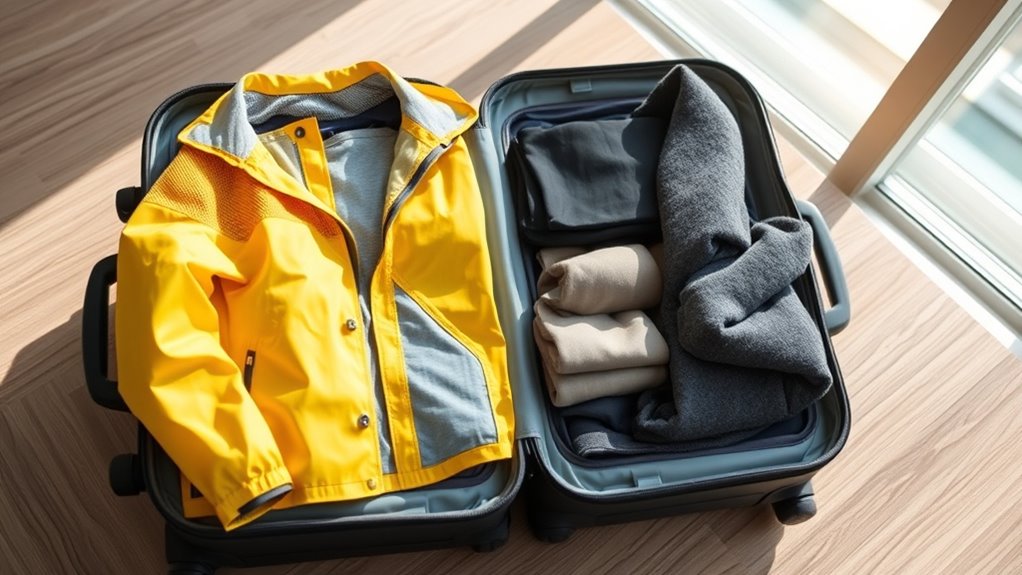
After evaluating the climate variability of your destination, selecting versatile clothing pieces allows you to adapt quickly to changing weather conditions. Focus on items made from fabric blends that offer flexibility, moisture-wicking, and quick-drying properties. Choose pieces in neutral or coordinating colors so you can mix and match easily, reducing the number of items you need. Prioritize multi-purpose clothing, like a lightweight jacket that works for rain or cool evenings, and adaptable pants or skirts. Look for items that can be layered or worn alone, ensuring you’re prepared for sun, rain, or a sudden chill. Incorporating layering systems into your wardrobe helps you adjust to different temperatures and weather scenarios seamlessly. Additionally, practicing space-saving techniques can help you maximize your packing efficiency, making it easier to carry everything you need without overpacking. Being aware of climate variability can also guide your choice of clothing and accessories, ensuring you’re prepared for unexpected weather changes. Understanding the different types of precious metals investments, such as gold IRAs, can help you diversify your travel funds and safeguard your assets. Remember, versatile clothing saves space and keeps your wardrobe adaptable, making your trip more comfortable and stress-free. Embracing the benefits of sleep and meditation practices can also enhance your overall travel experience, helping you stay relaxed and rejuvenated during your journey.
Packing Layering Essentials
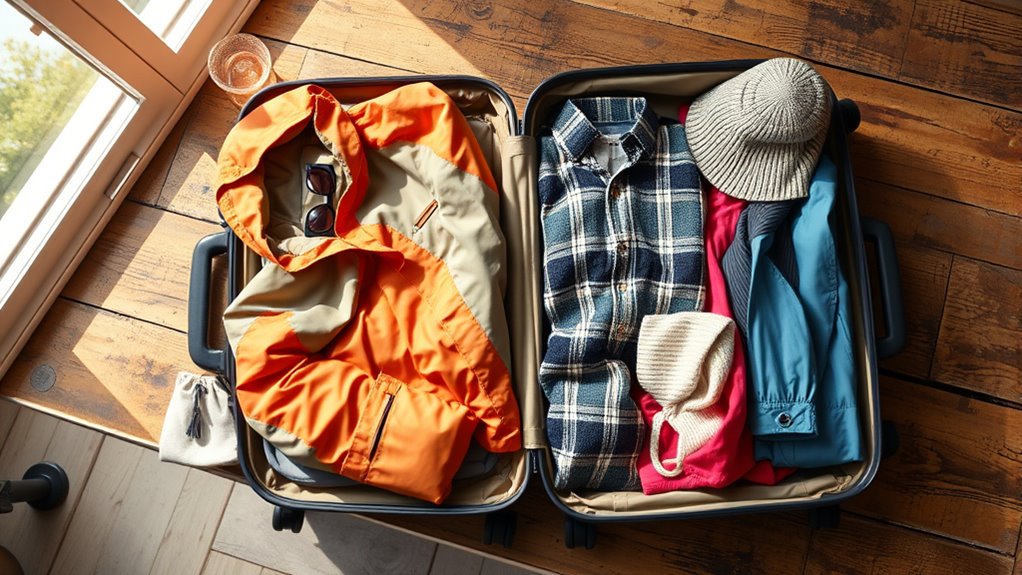
Layering your clothing is essential for staying comfortable in unpredictable weather. It allows you to adjust quickly to changing temperatures and conditions. Start with moisture-wicking base layers that manage sweat and keep you dry. Add thermal insulation pieces, like fleece or down, for warmth. Top with a waterproof or windproof shell to protect against the elements. Remember, layers should be lightweight yet effective. Use this table to understand the importance of each layer:
| Layer Type | Purpose |
|---|---|
| Base Layer | Moisture management, keeps skin dry |
| Insulating Layer | Thermal insulation, retains heat |
| Outer Shell | Weather protection (wind, rain) |
| Mid Layers | Additional warmth when needed |
| Ventilation Layers | Regulates temperature and moisture |
Proper layering guarantees comfort and adaptability during your trip, especially when considering the contrast ratio of your clothing choices to ensure optimal comfort in varying lighting conditions. Additionally, selecting appropriate fabrics for each layer can significantly enhance your comfort and efficiency in changing climates. Incorporating quality filters into your gear can also help in managing unexpected weather changes, ensuring your clothing layers perform effectively. Understanding clothing moisture-wicking properties is crucial for maintaining dryness and comfort in diverse weather conditions. Exploring variety in crochet styles and accessories can also add extra protection and style to your layered outfit when needed.
Choosing the Right Footwear for Multiple Conditions

Choosing the right footwear is essential when you’re facing multiple weather conditions, as your shoes need to balance comfort, protection, and durability. Waterproof boots are great for rain and snow, keeping your feet dry and comfortable. Casual sneakers are versatile for walking around town or mild weather, offering breathability and style. To stay prepared, consider packing:
Choosing versatile footwear ensures comfort and protection across diverse weather conditions.
- Waterproof boots for rain and snow
- Casual sneakers for everyday comfort
- A lightweight pair for quick shifts
This combination guarantees you’re ready for sudden changes in weather without sacrificing comfort or practicality. Make sure your footwear is well-broken-in and suitable for long walks. Proper footwear not only protects your feet but also keeps you moving confidently through diverse climates, especially when considering weather-appropriate footwear options.
Incorporating Weather-Resistant Gear
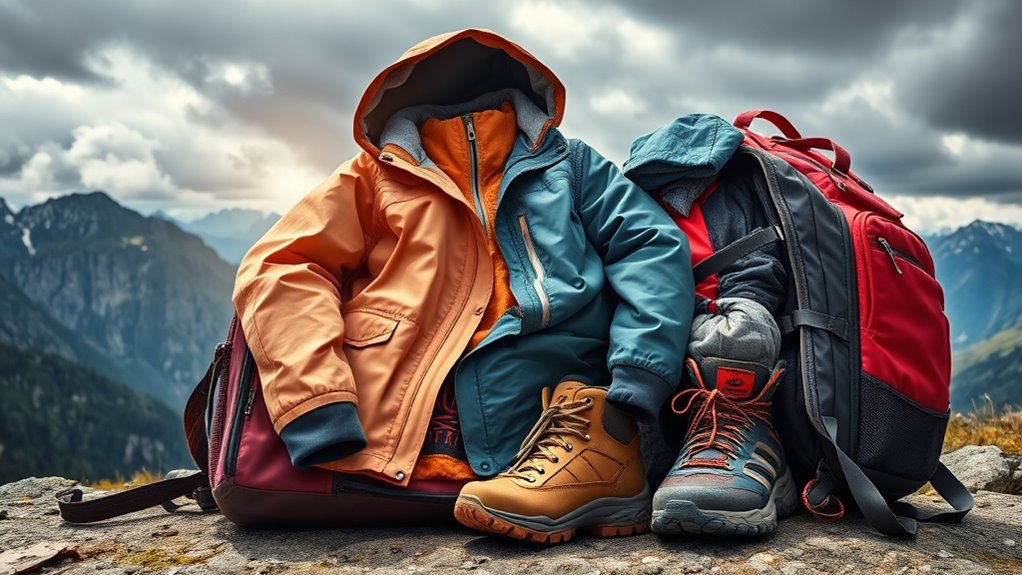
To stay dry and comfortable, you should choose weather-resistant gear made from durable materials that can handle the elements. Packing compact rainwear guarantees you’re prepared without taking up too much space, and multi-functional accessories add versatility to your wardrobe. Incorporating these items keeps you ready for unexpected weather changes, no matter where your trip takes you. Additionally, selecting gear with high-quality materials ensures better longevity and performance in diverse conditions. Regularly inspecting and maintaining your gear using proper care techniques can also help maintain your gear’s condition and extend its lifespan. Being familiar with waterproof fabrics can help you make informed choices when selecting your weather-resistant gear. Recognizing confident communication skills can also assist you in effectively managing unexpected weather challenges during your trip.
Choosing Durable Materials
When preparing for unpredictable weather, selecting durable materials becomes essential to keep your gear protected and functional. Opt for fabrics that withstand the elements, like waterproof fabrics that keep rain out and wind resistant textiles that block gusts. These materials guarantee your clothing and gear last through sudden storms or chilly breezes. Look for backpacks with reinforced stitching and abrasion-resistant surfaces to handle rough terrain. Choosing high-quality, weather-resistant gear minimizes the need for frequent replacements and keeps you comfortable on the go. Investing in durable materials means you’re prepared for whatever climate surprises you, making your trip smoother and more enjoyable. Weather-resistance technology can also offer reliable power to charge your devices in harsh weather conditions. Incorporating sustainable materials can further enhance your gear’s durability and eco-friendliness. Additionally, selecting fabrics with moisture-wicking properties can help manage sweat and keep you dry in changing weather. Being aware of the different climate zones you might encounter allows you to tailor your gear choices more effectively. Remember, sturdy gear isn’t just about protection—it’s about staying confident and comfortable in any weather.
Packing Compact Rainwear
Packing compact rainwear is essential for staying dry without adding bulk to your luggage. Choose rainproof fabrics that are lightweight yet durable, such as nylon or polyester with a waterproof coating. These materials keep moisture out while folding down small enough to fit into your bag. Don’t forget waterproof accessories like compact umbrellas or rain ponchos, which save space and provide quick protection. Look for items that pack tightly and are quick-drying, so you can easily store them away after use. Consider multi-purpose rainwear that can be worn over different outfits, reducing the need for multiple pieces. By selecting weather-resistant gear made from rainproof fabrics and waterproof accessories, you’ll stay comfortable and dry without sacrificing space in your luggage. Utilizing innovative design ensures your rainwear remains functional and adaptable for various climates. Additionally, choosing materials with moisture-wicking properties can help keep you dry and comfortable during unexpected rain showers. Being aware of emergency waterproof gear options can further enhance your preparedness for sudden weather changes, especially when recognizing recurring angel numbers that might signal upcoming weather shifts or personal guidance. Incorporating AI security insights can also help you select the most effective and reliable weather-resistant gear based on real-time weather data and safety recommendations.
Multi-Functional Accessories
Incorporating weather-resistant gear into your accessories allows you to stay prepared without adding extra bulk to your luggage. Multi-purpose accessories made from weather-resistant fabrics are perfect for unpredictable climates. They serve multiple functions and keep you dry and comfortable. For example, a compact scarf that transforms into a rain cover offers both warmth and rain protection. A lightweight, foldable hat made from weather-resistant fabrics shields you from sun and rain alike. Additionally, a versatile backpack with waterproof zippers and weather-resistant materials keeps your belongings safe during sudden downpours. These accessories eliminate the need for separate rain gear, saving space and weight in your luggage. Weatherproofing is a crucial aspect of incorporating multi-functional accessories for varying climates. By choosing multi-purpose accessories with weather-resistant fabrics, you maximize functionality and adapt easily to changing weather conditions. To further ensure your gear performs well, paying attention to material durability can enhance longevity and resilience in diverse environments.
Organizing Your Luggage for Flexibility
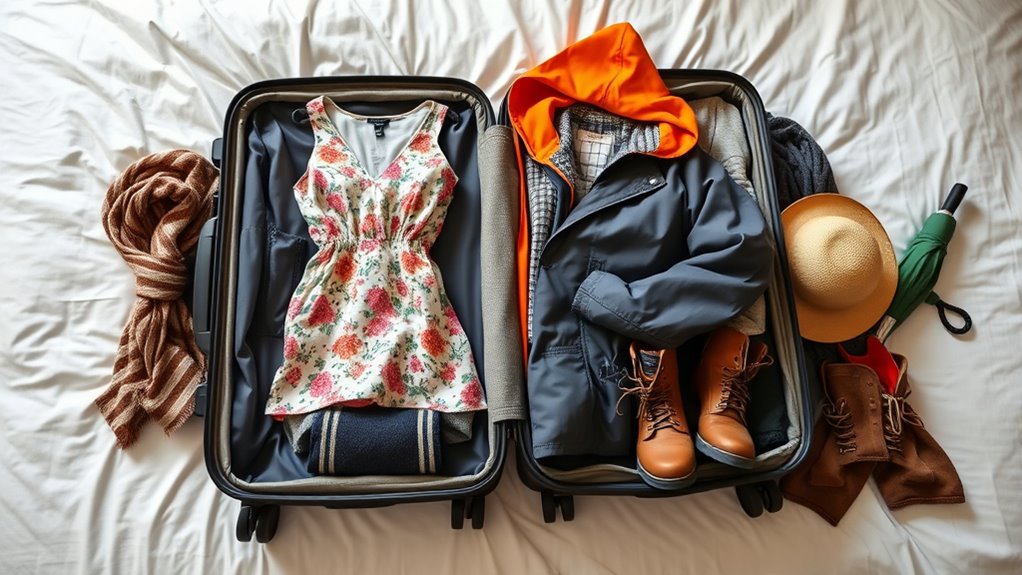
To guarantee your luggage remains adaptable to changing plans or weather conditions, organize your belongings in a way that allows easy access and quick adjustments. Use dedicated compartments or packing cubes to separate clothing by type or climate. Incorporate essential travel accessories like lightweight scarves, versatile layers, and compact rain gear for quick changes. Proper luggage organization helps you find items fast, saving time and reducing stress.
| Easy Access Zones | Items to Keep Handy |
|---|---|
| Top compartments | Light jackets, hats, sunglasses |
| Side pockets | Travel accessories, adapters |
| Inner sections | Layers, underwear, socks |
| Exterior compartments | Rain ponchos, quick-dry towels |
Planning for Sudden Weather Changes

You should pack versatile clothing layers so you can adjust to changing temperatures easily. Keep a close eye on the weather forecast to stay ahead of surprises. It’s also smart to have emergency supplies on hand in case conditions worsen unexpectedly.
Pack Versatile Clothing Layers
Since weather can change unexpectedly, packing versatile clothing layers is essential for staying comfortable and prepared. Focus on creating a capsule wardrobe with pieces that easily mix and match, so you can adapt to fluctuating temperatures. Layering allows you to add or remove clothing as needed, keeping you comfortable without overloading your luggage. To maximize versatility, choose clothing in neutral colors that coordinate well, making it simple to combine items for different looks. Consider packing:
- Lightweight, long-sleeve shirts for warmth and sun protection
- A compact, waterproof jacket for rain or wind
- Versatile scarves or wraps that can double as outer layers or accessories
This approach guarantees you’re ready for sudden weather shifts while maintaining a streamlined, stylish wardrobe.
Monitor Weather Closely
Keeping an eye on the weather forecast helps you adjust your packing plan as conditions change. Regular forecast updates reveal evolving weather patterns, so stay informed to avoid surprises. Check reliable sources daily, especially before heading out each day. Sudden shifts like rainstorms or temperature drops can happen unexpectedly, so be prepared. Use apps that send real-time alerts for weather changes in your destination. Tracking forecast updates allows you to layer appropriately or add essentials like rain gear or extra warmth. Remember, weather patterns can be unpredictable, so flexibility is key. Stay vigilant and adapt your plans accordingly. Here’s a quick overview:
| Weather Pattern | Action to Take |
|---|---|
| Sudden Rain | Carry portable umbrella, waterproof jacket |
| Cold Snap | Add thermal layers, warm accessories |
| Heatwave | Wear breathable fabrics, stay hydrated |
| Windy Days | Secure loose items, wear wind-resistant clothing |
Prepare Emergency Supplies
Preparing for sudden weather changes means packing emergency supplies that can keep you safe and comfortable when conditions shift unexpectedly. Having well-prepared safety kits ensures you’re ready for storms, temperature drops, or other surprises. Your safety kit should include essentials like a flashlight with extra batteries, a whistle to signal for help, and a basic first aid kit for minor injuries. Consider packing high-energy snacks and water to stay nourished and hydrated during emergencies. Keep these supplies in an accessible bag, so you can grab them quickly if needed. Remember, quick access to emergency supplies can make all the difference during sudden weather changes, helping you stay safe until conditions improve. Proper planning guarantees you’re prepared for anything nature throws your way.
Packing Compactly Without Missing Essentials

To pack effectively without missing essentials, focus on organizing your clothing and gear around the weather forecast and planned activities. Use versatile clothing that can layer easily, and pack travel gadgets that serve multiple purposes. Consider cultural considerations by researching dress codes or customs, ensuring respectful attire. To maximize space, roll clothes tightly and select lightweight items. Here’s a simple guide:
| Essentials | Optional Items |
|---|---|
| Layered clothing | Compact umbrella |
| Travel gadgets | Cultural attire |
| Socks and underwear | Small first aid kit |
| Weather-specific gear | Lightweight shoes |
| Important documents | Travel-sized toiletries |
Smart packing helps you stay prepared and adaptable without overloading your bag.
Tips for Staying Comfortable in Unpredictable Weather
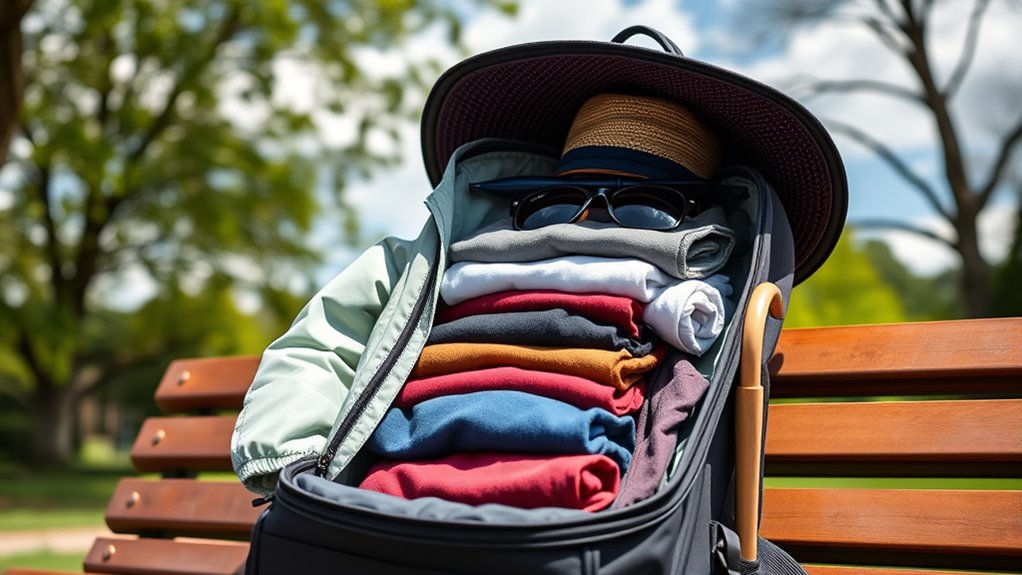
When weather conditions are unpredictable, staying comfortable requires flexibility and quick adjustments. Pack versatile clothing like a lightweight rain jacket and breathable layers to adapt easily. Keep sun protection in mind—wear a wide-brim hat, sunglasses, and apply sunscreen regularly to shield yourself from sudden sun exposure. Insect repellent is essential, especially in humid areas or near water, to prevent bites and discomfort. Be prepared for surprises with a compact umbrella or a quick-drying towel for drying off after rain. Staying alert and adjusting your plans accordingly helps you stay comfortable no matter the weather. Remember, being proactive with sun protection and insect repellent ensures you enjoy your trip without unnecessary discomfort or interruptions.
Frequently Asked Questions
How Can I Predict Unexpected Weather Changes During My Trip?
You can stay ahead of unexpected weather changes by regularly checking weather alerts and seasonal forecasts for your destinations. Download reliable weather apps that provide real-time updates, so you’re instantly informed of sudden shifts. Keep an eye on local news and weather websites, and pack versatile clothing to adapt quickly. Being proactive with these tools helps you respond promptly to changing conditions, ensuring your trip remains comfortable and safe.
What Are the Best Materials for All-Weather Clothing?
You should choose clothing made from advanced fabric technology like moisture-wicking materials, which keep you dry and comfortable in all climates. Look for all-weather fabrics such as polyester blends or merino wool, known for their durability and breathability. These materials help regulate temperature, dry quickly, and resist odors, making them perfect for unpredictable weather. Always prioritize versatile, lightweight options that adapt to changing conditions during your trip.
How Do I Prevent Luggage From Becoming Too Heavy?
You can prevent your luggage from becoming too heavy by choosing lightweight fabrics that save space and weight. Use packing cubes to organize your clothes efficiently, compressing items and maximizing space. Avoid packing bulky items unnecessarily, and plan to wash clothes during your trip. This way, you stay light on your feet and in your luggage, making travel easier and more manageable.
Can I Use Digital Tools to Plan My Packing for Climate Variability?
Yes, you can use digital tools to plan your packing for climate variability. Digital packing apps help you organize clothing based on forecasted weather, ensuring you bring versatile pieces. Weather apps provide real-time updates on temperature and conditions at your destination, so you can adjust your packing list accordingly. These tools streamline preparation, prevent overpacking, and help you stay comfortable in changing climates during your trip.
How Should I Adjust My Packing List for Different Seasons in One Trip?
To adjust your packing list for different seasons, focus on seasonal layering, so you can add or remove clothing as needed. Pack versatile accessories like scarves, hats, and gloves to adapt to varying temperatures. Include lightweight options for warmer days and warmer layers for cooler moments. This approach keeps your luggage manageable while ensuring you’re prepared for all weather changes during your trip.
Conclusion
By packing smart for multiple climates, you stay comfortable no matter what Mother Nature throws your way. Imagine hiking in the morning sun, then braving a sudden rainstorm—your layered clothing and waterproof gear keep you dry and happy. With thoughtful planning, you can enjoy every moment of your trip without stress. So, next time you head out, remember: flexible packing isn’t just smart, it’s essential for embracing unpredictable weather and making the most of your adventure.
